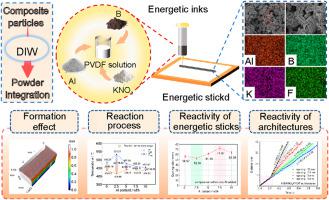Effects of Al powder on the reaction process and reactivity of B/KNO3 energetic sticks
IF 3.9
Q2 CHEMISTRY, MULTIDISCIPLINARY
引用次数: 0
Abstract
Boron/potassium nitrate (B/KNO3) is a type of critical energetic composite material (ECM). However, the inert oxide layer on the B surface of B/KNO3 hinders the contact between pure fuel and oxidant, thus limiting energy release This limitation could be eliminated by adding highly reactive Al powder. To discern the effects of Al powder size on the reaction process and reactivity of B/KNO3, this study prepared Al/B/KNO3/polyvinylidene fluoride (PVDF) energetic sticks using the direct ink writing (DIW) technology. This study characterized the macroscopic morphology and structure of the energetic sticks using a laser scanning microscope and a scanning electron microscope, examined the reaction process of the composites using a differential scanning calorimeter and a thermogravimetric analyzer, and observed the flame propagation behavior of energetic sticks and energetic architectures using a high-speed camera. Furthermore, it tested the pressure output characteristics of the energetic composites using a closed volume tank. The results show that adding Al powder can improve the combustion efficiency of B/Al composite fuels and reduce the agglomeration of the combustion products. The Al powder with various particle sizes affects various reaction stages of the composite. The combustion and pressure output tests suggest that adding Al powder with a particle size of 1 μm yielded high reactivity and that flame jump propagation appeared in energetic architectures when the channel spacing was below 10 mm. These findings provide a guide for modifying the B/KNO3 energetic composites and regulating the reactivity of energetic sticks.


Al粉对B/KNO3含能棒反应过程及反应活性的影响
硼/硝酸钾(B/KNO3)是一类临界能复合材料(ECM)。然而,B/KNO3表面的惰性氧化层阻碍了纯燃料与氧化剂的接触,从而限制了能量的释放,这一限制可以通过添加高活性的Al粉来消除。为了研究Al粉末粒度对B/KNO3反应过程和反应活性的影响,本研究采用直接墨水书写(DIW)技术制备了Al/B/KNO3/聚偏氟乙烯(PVDF)能量棒。利用激光扫描显微镜和扫描电子显微镜表征了含能棒的宏观形貌和结构,利用差示扫描量热仪和热重分析仪考察了复合材料的反应过程,并利用高速摄像机观察了含能棒和含能结构的火焰传播行为。此外,利用密闭容积罐测试了含能复合材料的压力输出特性。结果表明,添加Al粉可以提高B/Al复合燃料的燃烧效率,减少燃烧产物的结块。不同粒径的铝粉对复合材料的不同反应阶段产生影响。燃烧和压力输出实验表明,加入粒径为1 μm的Al粉具有较高的反应性,当通道间距小于10 mm时,火焰在含能结构中出现跳跃传播。这些研究结果为B/KNO3高能复合材料的改性和高能棒反应性的调控提供了指导。
本文章由计算机程序翻译,如有差异,请以英文原文为准。
求助全文
约1分钟内获得全文
求助全文
来源期刊

Energetic Materials Frontiers
Materials Science-Materials Science (miscellaneous)
CiteScore
6.90
自引率
0.00%
发文量
42
审稿时长
12 weeks
 求助内容:
求助内容: 应助结果提醒方式:
应助结果提醒方式:


